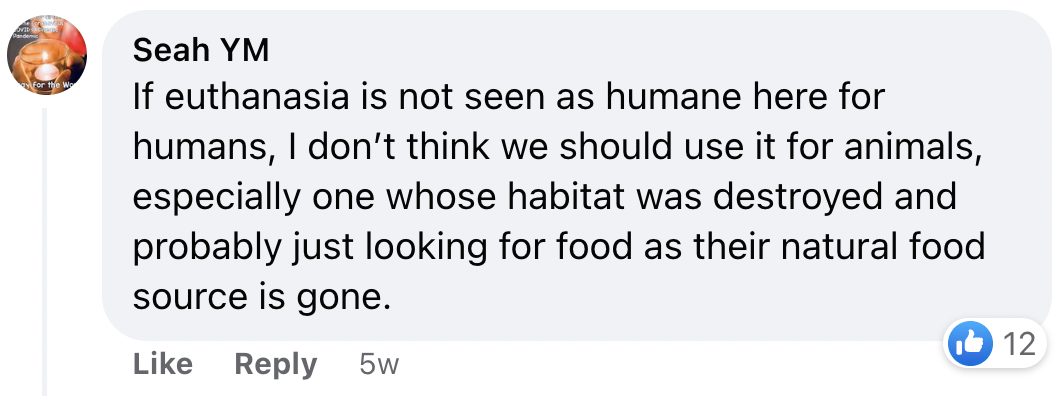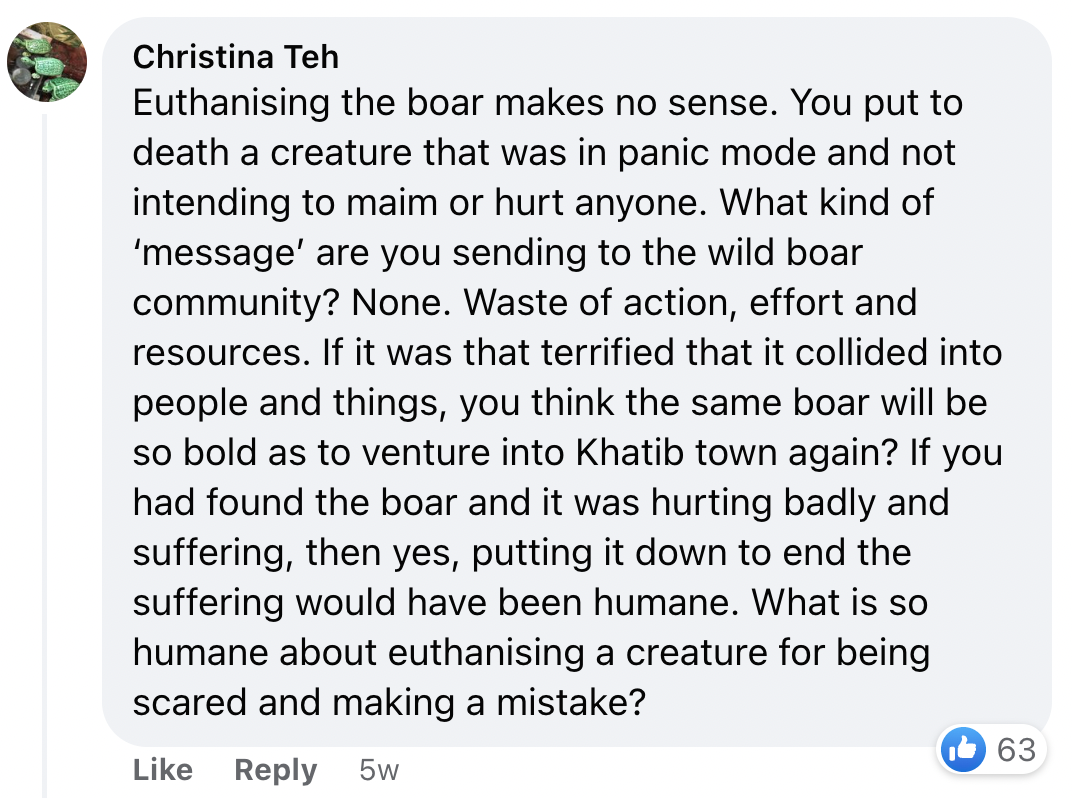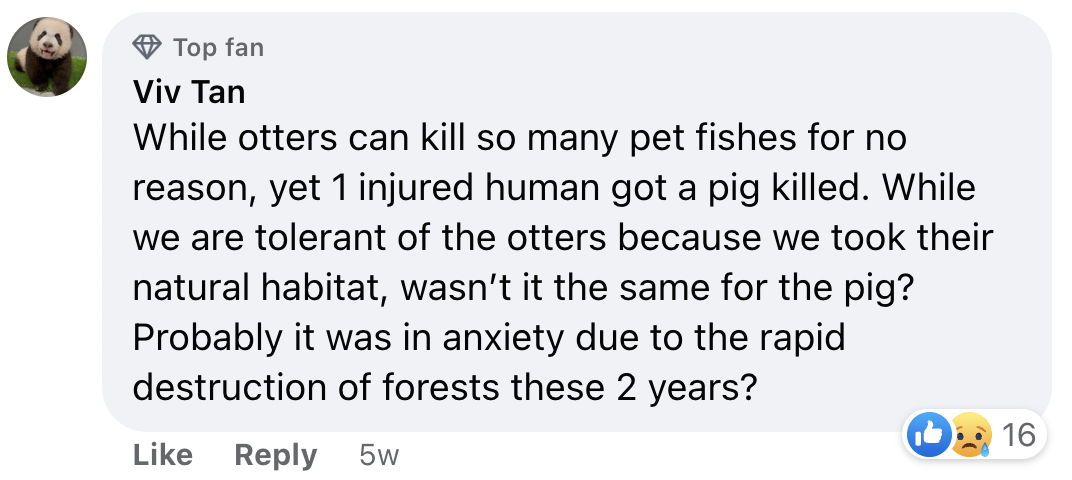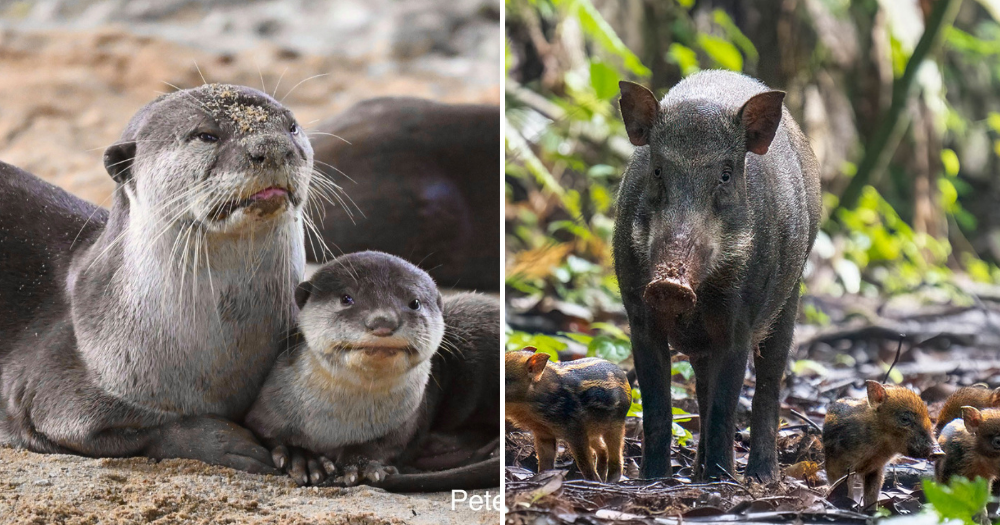Hear a chorus of squeaks as you make your way through a park or along a park connector in Singapore, and you'll know what to look out for.
Chocolate brown fur, beady eyes, long tails and a loping gait, otters have invaded the hearts, souls, and — to certain individuals' distress — homes of those on our island.
Singaporeans have become increasingly endeared to these amphibious creatures with their family units and human-like antics, but as they criss-cross our urbanised space, tensions seem to be rising with more occurrences of human-otter conflict.
The otter side
First, let us briefly dive into the celebrated and historic return of otters in Singapore.
For around three decades, Singapore was otter-less, until the appearance of a squeaky pair in 1998 at Sungei Buloh Nature Reserve. It is postulated that the two smooth-coated otters swam across the Johor Straits from Malaysia.
There was no reclamation at the northwestern coastline yet, ensuring a suitable habitat for the otters to put down roots.
Having "colonised" the northern shore of Singapore, and with a conspicuous lack of predators in our waterways, otter sightings slowly increased over the years as the animals spread islandwide.
One factor that contributed to their return and growth was also the government's massive clean-up operation of the Singapore River and Kallang Basin from the 70s to 80s, making the waterways inhabitable once again.
Today, there are an estimated 150 otters here. As the wild otter population flourished, so has Singapore's collective love for the furry creatures.
Their adorable faces, combined with the tale of their plucky comeback in Singapore, with perhaps a dash of nationalistic pride that "wow, they really chose our country as their home!", have transformed otters into such a local icon that they were voted to represent Singapore's 51st National Day in a 2016 The Straits Times poll.
They've even become a prominent feature in the government-developed TraceTogether app.
One could say though, that you can certainly have too much of a good thing.
Thus far, they've bitten stray joggers and passers-by, and crossed the thresholds of homes to rip apart prized koi fish, leading to some labelling them as pests and a menace.
Humans' adoration, it seems, has gradually festered into vexation.
Otters vs. wild boars
A recent case of human-wildlife conflict involving a wild boar at Yishun led to swift comparisons about the perceived differing treatment that the two species face after it was revealed that the boar was euthanised.
Harsh words like "discrimination", "murder", and "unfair" were flung about in the online space, which begs the question — is there really a difference in wildlife management? Are we simply swayed because otters are cuter and more beloved?
For those who were not following the news, this wild boar had somehow found its way into the bustling Khatib Central and head-butted a woman, knocking her out for 15 minutes, on March 10, 2022.
The wild boar fled to the only green space nearby, Yishun Park, which was subsequently closed off by National Parks Board (NParks) officers with hoardings.
The boar was trapped 10 days later and "euthanised humanely for public safety".
The conclusion to this incident resulted in numerous negative reactions online.


Otters were quickly dragged into the discussion.



This statement by one Facebook user pretty much sums up the comparisons made between otters and wild boars.
"There've been incidences of otters biting people, but they don't get euthanised. Probably cos they look cuter? Double standards much? Things that animals (and humans) get away with based on looks!"
It brings to mind a recent term that has gained prominence among the younger generations on TikTok — "pretty privilege", which is used when someone who is more attractive based on societal beauty standards is granted more opportunities and lenience.
Comparing the two species are like comparing apples to oranges
It seems the above incidents have led people to wonder if otters have "pretty privilege". Was the wild boar euthanised just because of its warty, less adorable appearance?
"My first response is, people don't understand how fierce and tough wild pigs can be," N Sivasothi, a biologist and lecturer at the National University of Singapore, said.
"It's not something NParks can wait while the pig finds its way back to the forest and allow it to wander the areas la. I think people grossly underestimate the pig."
Urban areas are particularly stressful for wild boars, with so many external stimuli. "Wild boar behaviour is such that when it is stressed, it runs in an erratic manner," Acres co-CEO Kalai Vanan told Mothership.
A distressed wild boar will be disorientated, and if it feels threatened, it will instinctively charge at individuals even if they do not pose a threat.
Wild boars' unpredictable behaviour make them a bigger danger to humans than otters, who typically attack only when there are pups in the pack — the latter has been the case for the majority of otter attacks in Singapore, Sivasothi notes.
Additionally, wild boars can reach weights of up to 100kg — a single hit to the body from a wild boar is likely to incur much more damage than bites and scratches from a family of otters.
But what about the incident where a jogger received 26 bites after, literally, running into an otter family at the Singapore Botanic Gardens, you might ask?
Sivasothi described it as an "unfortunate accident". As the man had fallen onto the ground, his low height made it easier for otters to sink their teeth into the man's legs, causing damage that they are typically unable to.
Otters are also more well-adapted to urban spaces than wild boars. The waterways in Singapore which they call their homes are right next to busy park connectors and recreational spaces, and the critters have become familiar to the sight and presence of humans.
They thus have a "higher coexistence factor" with humans, Sivasothi shared.
"Otters' zone of interaction is mostly with humans' recreational space, and the otter is not big enough to be a significant human threat, so if they're given some space, they recognise people and just move around them. They're highly habituated."
Wild boars, however, have all their needs met inside forests and green spaces, which see much less human traffic. There is little necessity for them to venture out to urban areas.
This naturally makes them warier of others whenever they do exit their forested homes, lured by improperly-disposed-of waste at void decks.
With these various factors at play, comparing wild boars and otters is almost like comparing apples and oranges.
Relocating wild boars — sounds easy but not really
So if wild boars are truly a greater concern to public safety than otters, why not relocate the one stuck in Yishun instead of euthanising it?
Both Sivasothi and Kalai admit that relocating a wild boar "may sound very easy in principle". It is anything but.
Wild boars are prey species — capturing them will place undue stress on them, which might cause them to go into shock and die.
They also have a tendency to bash around in the confines of their enclosure during captivity, and the boar might end up in a poorer condition when it is released, as compared to before it was captured.
However, Kalai feels this reasoning can sometimes be used as an easy way out.
"This is the reasoning often given to why you can't, or why it's tricky to relocate these animals. Because when you relocate them, you release them, they often just run, and they collapse and die eventually. However, it is not always true because there have been many cases where such animals have been relocated properly and they're fine.
So sometimes I feel this can be used as an excuse not to relocate the animals."
Nevertheless, another problematic aspect of relocation is where the boar can be moved to.
Relocating the boar into another boar's existing territory is out of the question, or the two might clash.
Additionally, different parcels of land belong to different government agencies, and relocating any animal to any plot of land requires the respective authorities' permission.
Ultimately, Kalai is left with one question after this incident."If you have a wild pig from Yishun and you're gonna relocate it somewhere else, the question then becomes where is that somewhere else, who does the land belong to, and are the owners of that piece of land okay to have a wild boar?"
"What is the population of wild boars in Singapore, what is the carrying capacity (the number of animals the environment can support), and are we exceeding? If we aren't, why are we euthanising wild boars instead of trying to relocate them or trying to sterilise them?"
Although euthanasia is never an ideal option, Sivasothi on the other hand, believes the authorities did the best they could in that predicament.
"So now you have a pig isolated within Yishun park, within hoarding, with NParks monitoring and figuring out how to bait it so that they can catch it. So the pig's not under any duress. The hoarding is there to ensure that the people in the urban spaces, who are not gonna expect a pig turning up, don't have to face a confrontation. So I thought that was very well [done] you know, they reacted very fast and isolated it."
Nevertheless, he reiterated the same points Kalai brought up.
"The issue of humanely releasing a pig is not so simple, and then the question is where. So I don't know... if I was in that situation, I'll probably end up doing the same thing that [NParks] did."
Back to the question about "pretty privilege"
The otter-loving community is prominent on social media.
There are photographers dedicated to snapping National Geographic-worthy shots of the critters, and groups like Ottercity and OtterWatch have formed where users come together to coo over the animals.
Tellingly, there aren't any groups dedicated to wild boars.
But as a result of dedicated efforts by otter watchers to document and share their observations with the public, we get to see the amphibious creatures cuddling with their pups, having sand baths, or just chilling while being cute.
The smooth-coated otters in Singapore are also classified to be a vulnerable species globally.
Singapore has become one of the rare sanctuaries in the world where these otters can be conveniently observed and studied, drawing visitors from around the globe just to catch a glimpse of them.
In contrast, wild boars, which are nocturnal and remain cloistered inside forested areas, are shrouded in mystery. They are classified as a species of Least Concern, due to their adaptability and fast reproduction.
Kalai describes the supposed uptick of support for wild boars following the hullabaloo about what happened at Yishun as support for the "underdog".
"It was worse back then because [wild boars] were seen as dangerous, but now otters are seen eating people's koi fish, they think of [otters] as very atas, and then the wild boars become the underdog. Nowadays, even snakes become the underdog.
...It's just a very natural way of how things happen on social media la, I think."
Therefore, the gripe that most people now have is whether the otters' perceived pretty privilege affects how they are managed, or rather, whether their management is indifferent to it.
Public complaints will result in attention on specific species, but it depends on whether the government has a "holistic grasp of issues", Sivasothi says.
"If it's skewed by whose voice is the loudest then that's not governance already."
Sivasothi disagrees with the "pretty privilege" notion, stating that cases of human-wildlife conflict are typically guided by a science-based approach. In Singapore, wildlife groups and organisations like Acres, Mandai Wildlife Group, and Otter Working Groups are consulted, alongside wildlife experts like Sivasothi himself.
"It's not blind excitement over something that is cute," he notes, stating that there are numerous variables that contribute to how an animal is managed.
Kalai echoes the same sentiments. For animals that live in packs like otters, the chances of an injured individual recovering and being able to keep up with its family members after its release are slim, and oftentimes, euthanisation is the only option remaining.
"It's not like because the otters are so favoured, when they get injured, there's a huge amount of resources put in to try to change the outcome."
Coexistence and compromise is key to a City in Nature
The answer to the question is thus, yes, maybe otters have a huge fanbase due to its appearance and antics, but privileged? Not really, when it comes to wildlife management in Singapore.
As Singapore grows to become a City in Nature, more of such human-wildlife conflicts are expected to occur and understanding of these wild animals that share their homes with us needs to be attained.
For humans and wild residents to live harmoniously, Sivasothi cites three crucial factors — 1) The environment and infrastructure which affect the zone of interactions wildlife have with humans; 2) The animals' behaviour and; 3) Humans' behaviour.
Humans' behaviour, Sivasothi says, is the easiest to alter.
"There are those that expect the government to come up with some solution. But over time if the same problem [of otters entering people's homes] is happening, then they realise they are the best people to bring about change. The infrastructure has certain fixed features, then the otters will behave in a specific way. The third parameter is the easiest way to make a difference.
[People's] mindset [has to] shift from blame towards solutioning."
This includes avoiding culling as the go-to response, as some members of the public have proposed for what they believe to be an 'exploding' otter population here.
"Culling is very lazy language la, it comes from an ignorance of other kinds of strategies," Sivasothi candidly opined.
The otter population, in fact, needs no culling. Territorial disputes between the various otter families keep the population in check.
The wild boar population, on the other hand, might be bigger than that of otters. Even then, the boar population can be controlled through sterilisation, or reducing high-energy food sources such as palm oil.
Additionally, social media might easily skew the perceptions of certain animals, but it can also be a force for good by helping to raise awareness of the wildlife we have to coexist with.
Already, novices are joining wildlife sighting groups on Facebook to seek help to identify wild creatures, and the sharing of knowledge can help to overcome stereotypes surrounding certain species.
Kalai says:
"As we go into City in Nature, people also need to realise that you… don't get to choose what wildlife you come into contact with. So wildlife, it's not something that is there for your own amusement or your own relaxation. It's there because they were there before us and they're there for their own right to live."
More compassion
For anyone to be willing to change their behaviour to coexist with individuals outside of our own species, there needs to be a sense of compassion for wild animals.
Kalai believes that the Singapore authorities can lend a helping hand by raising awareness for less popular animals like wild boars instead of "favouring certain species".
"So we need to see all species equally as much as possible. I can't say we can be 100 per cent equal, but we should be try to be more equal and less biased."
For Sivasothi, who has been studying and tracking the otters across the decades and has even dubbed himself the "Otterman", the otters are simply an example of the sheer potential tiny Singapore holds for nature and biodiversity.
"The ability of otters to survive this far [in Singapore] is phenomenal," he marvels.
Top photo by Peter Swee via Ottercity / FB and Angeline Ooi / FB
If you like what you read, follow us on Facebook, Instagram, Twitter and Telegram to get the latest updates.
